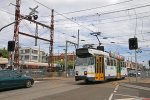Slightly off-piste, but when the London Overground circuit was completed, there were a few places where it changed from third rail to overhead. Most of them occurred a stations, so nobody noticed, but on the west side, there was one changeover that occurred mid-way between two stations (Shepherds Bush and Willesden Junction) and at one time the trains used to stop to make the change and put the pantograph up. I think this was probably because the train systems needed to shut down and re-boot to the different voltage / current arrangements.
With the newer Bombardier 378 units, they have been able to make the changeover 'on the fly' and passengers do not notice the difference.



